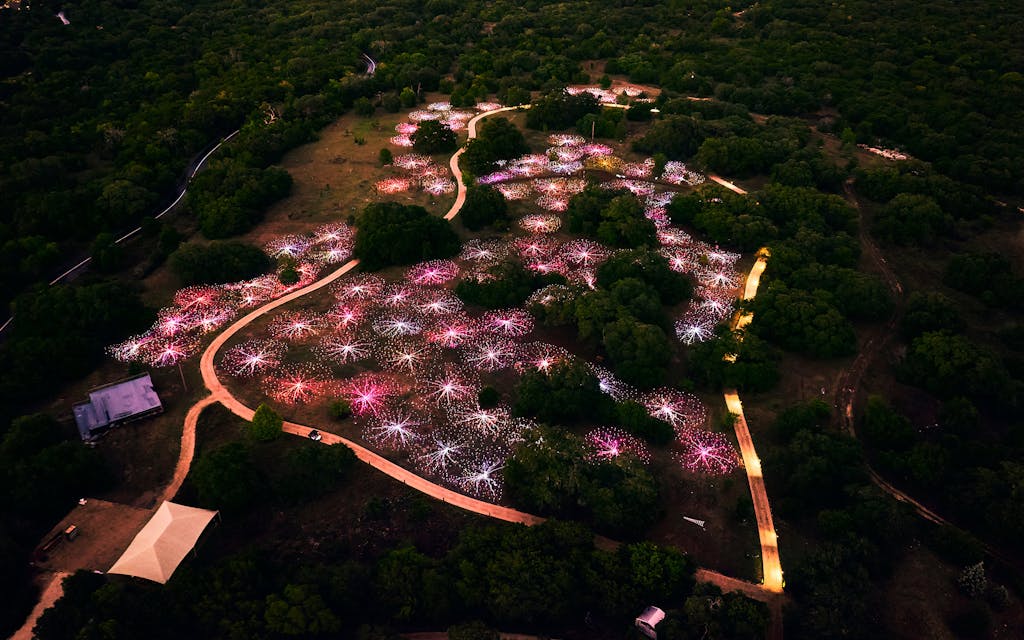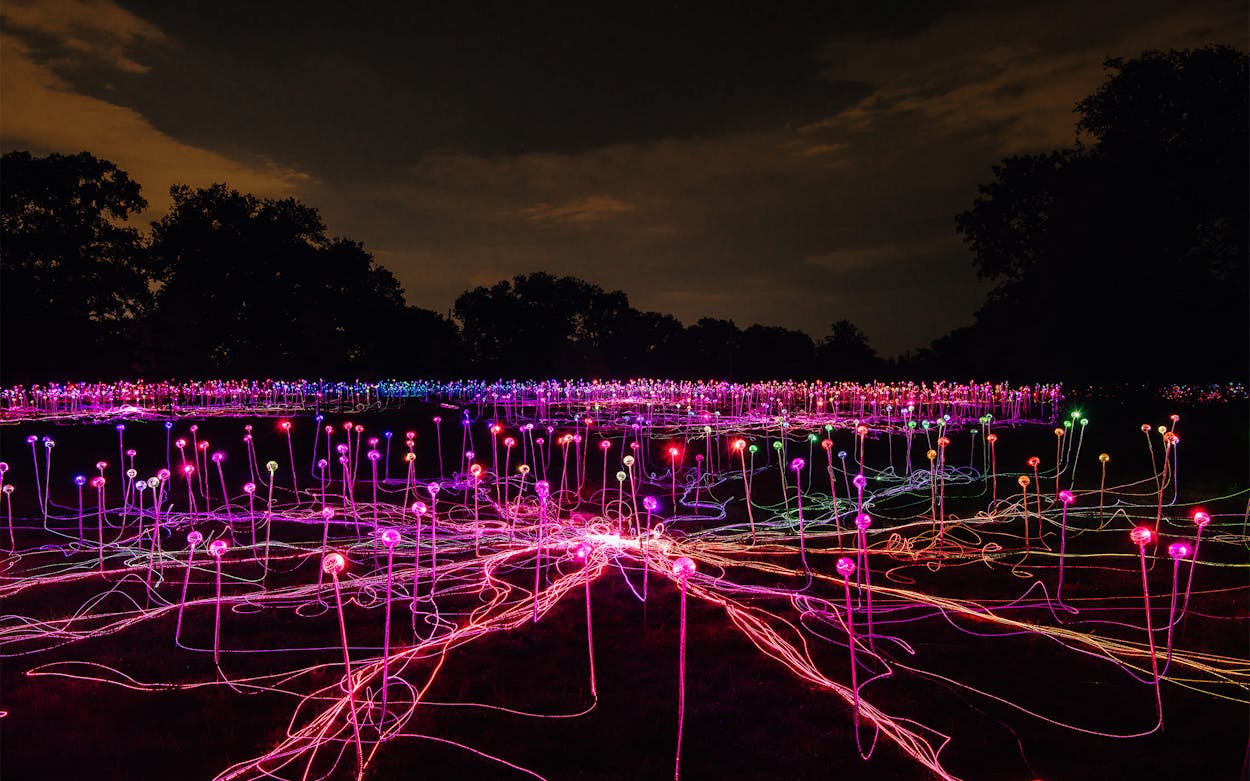As a trio of deer bounded across the gardens at the Lady Bird Johnson Wildflower Center on a recent morning, they deftly avoided glass orbs on slender, flexible stems. The humans who were installing thousands of these tangerine-size bulbs weren’t always as graceful. One got briefly tangled in a network of fiber-optic threads, while others gingerly picked their way through the glistening web of wires.
In all, 28,000 solar-powered spheres, each containing a fiber-optic thread that slowly changes color, will create waves of muted luminosity over sixteen acres in the center’s Texas Arboretum as part of Field of Light, a site-specific exhibit by British artist Bruce Munro that opens September 9. Visitors will need tickets to stroll a 0.58-mile gravel path through the swaying display, a glowing mash-up of nature, technology, and art. It’s one of more than fifty large-scale, illuminated installations Munro has created around the globe since 2004, including more than twenty versions of Field of Light, from London to Mexico City. C3 Presents, which puts on the ACL Music Festival, collaborated with the Wildflower Center to bring the work to Austin through December.
“One of my wishes is to really get people to see how beautiful the natural environment is,” Munro says. “I believe these exhibitions can help a little bit to drive people toward gardens.”
He says he was inspired to create Field of Light about thirty years ago after visiting Uluru, also knowns as Ayers Rock, a massive sandstone monolith in central Australia that appears to change color with the sun’s movement throughout the day. “I didn’t want to look at it on a wall,” he says of his work. “I wanted people to walk through a space and feel it was growing around them.”

A team of four designers from England, along with about 250 Wildflower Center volunteers, spent four weeks installing the display in August. It was hot, sweaty business, so crews began work at 5 a.m. each day to avoid peak heat. Designer Redd How, with Bruce Munro Studio, called it the most labor-intensive installation the studio has ever done, thanks to triple-digit temperatures and hard-packed soil the consistency of cement.
To create the display, workers and volunteers unspooled nearly 150 miles of fiber-optic filament, tucked it inside flexible stems and bulbs, then “planted” the stalks in the ground. At first, they needed power drills to bore five-inch holes in the drought-hardened soil to install each stem. When rain finally fell, softening the dirt, they could push the stems into the ground by hand.
“It sounded like something neat to do, to be outside and working with others and making something that’s going to be beautiful,” volunteer Cheryl Sebastian said last month as she attached a clear glass globe to a stem.
And the display is stunning. The glowing filaments create a sweeping, changing palette of color that moves with the breeze. “It’s not neon; it’s not Las Vegas,” says How. “It’s subtle, pastoral colors that are meant to calm.” The stems may bend, but they are deceptively sturdy. Past exhibits have withstood everything from cyclones to hail.
Technology has changed since the first iteration of Field of Light went up in London in 2004. Then, Munro used halogen bulbs that required extension cords and more electricity. The Austin exhibit uses LED lights powered by 35 solar panels scattered among the stalks. “Solar solves a lot of the logistical problems,” says Jon Pattillo of AvecMode, which helped with the installation. “These are self-sustaining, and we have plenty of sun here. We could go twelve days with absolutely zero light, and it would still work.”
The concept, though, sparked controversy among some Austin residents who saw photos of the installation on social media. Some worried that it would disrupt the fall bird migration; others suggested it would bother insects or other wildlife. “This is another example of humans invading a natural area, not preserving it,” one commenter posted on Facebook.
Wildflower Center officials said that they consulted with staff experts and the Audubon Society before the installation began. The exhibit is open four nights a week, and organizers will turn off the solar-powered batteries to the lights by 11 p.m., in accordance with the Audubon Society’s Lights Out Texas campaign to protect birds during the fall migration.
“I do hear what people are saying, but they need to understand the nature of the installation,” says Munro, who notes that the entire exhibit uses no more power than an average home during those hours. He says his exhibits are meant to be light on the carbon footprint and nonintrusive. Materials are reused and recycled, and the work is lit for less than four hours a night, four nights a week. “Yes, it is a light installation, but the whole point is to balance it with the natural light of the environment—the stars and the sky,” he says.
A portion of proceeds from the display will be used to support the Wildflower Center’s native plant research, education, and outreach programs.
Field of Light will be open from about 6:45 to 10:30 p.m. on Thursday through Sunday nights through December. Tickets start at $41 for adults and $20 for children and are available at fieldoflightaustin.com.






